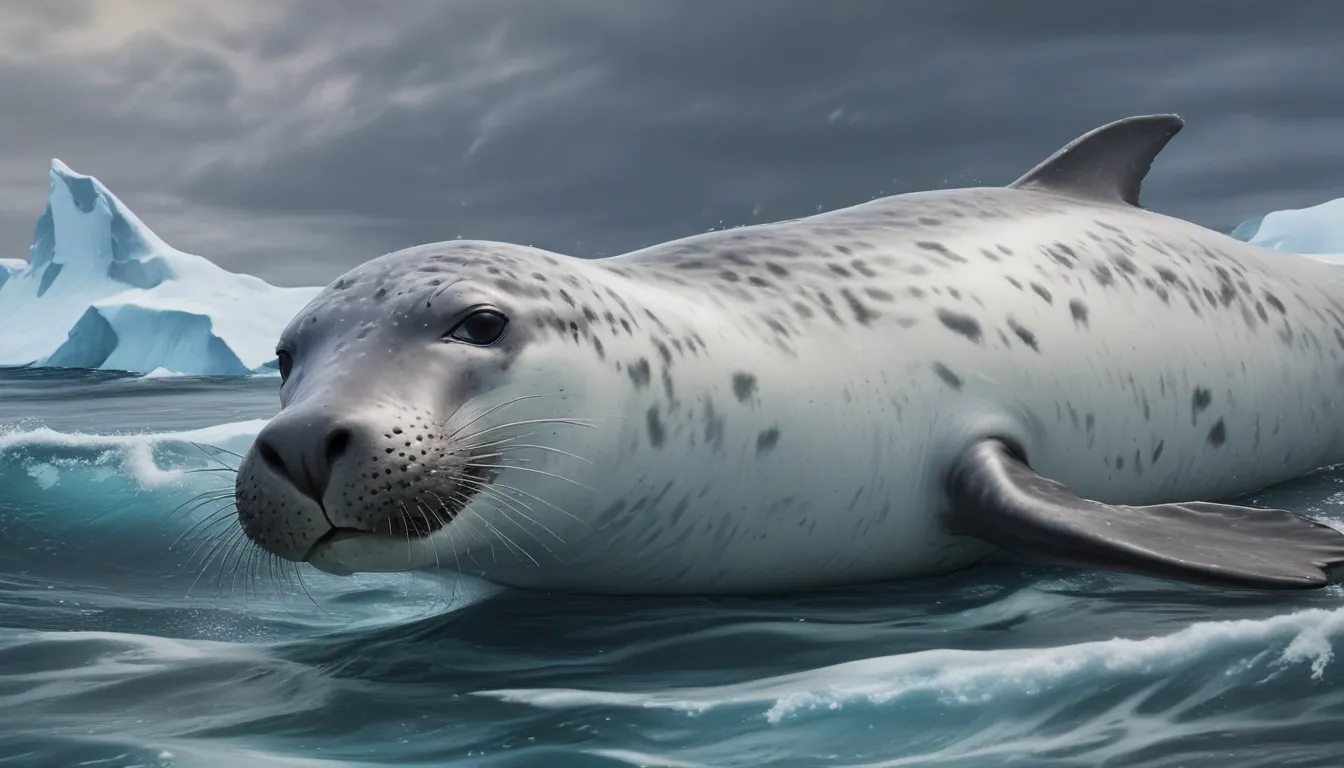The pictures we use in our articles might not show exactly what the words say. We choose these pictures to make you interested in reading more. The pictures work together with the words but don’t take their place. The words still tell you the important facts.
Have you ever pondered about the enigmatic creatures that inhabit the icy waters of Antarctica? Let's embark on a journey into the realm of leopard seals, one of the most captivating predators lurking beneath the frigid waves. These seals are far from ordinary marine mammals; they are unique, powerful, and brimming with surprises. Renowned for their striking appearance and exceptional hunting skills, leopard seals have become a subject of fascination and admiration. Their solitary nature and unconventional diet unveil a world of complexity, offering a glimpse into the intriguing lives of these Antarctic dwellers. Are you ready to delve into the realm of these icy predators? Join us as we unravel some captivating facts about leopard seals that will ignite your curiosity and challenge your perceptions of these majestic creatures.
Diving Deep into Leopard Seals
Leopard seals, aptly named for their spotted coats reminiscent of their terrestrial counterparts, rank among the most formidable predators in the Antarctic waters. These seals not only exhibit remarkable swimming capabilities but also boast a set of razor-sharp teeth, perfectly suited for their carnivorous diet.
- Leopard seals (Hydrurga leptonyx) stand as the third largest seal species in Antarctica, trailing behind the southern elephant seal and the Weddell seal. Adults can grow up to 3.5 meters (11.5 feet) in length and weigh over 600 kilograms (1,320 pounds).
- Their diet showcases surprising diversity, encompassing fish, squid, penguins, and even smaller seals. This adaptability in feeding habits underscores their prowess as apex predators within the icy expanse of their habitat.
Unveiling the Habitat and Distribution of Leopard Seals
Leopard seals are solitary beings predominantly found in the cold waters encircling the Antarctic ice. Despite their primary habitat, they have been sighted as far north as the coasts of Australia, New Zealand, and South America, demonstrating their ability to traverse vast expanses of the ocean.
- Unlike numerous other seal species that gravitate towards stable ice floes, leopard seals frequently hunt in the dynamic and unpredictable pack ice zone. This region affords them ample opportunities to ambush unsuspecting prey.
- Throughout the Antarctic summer, they tend to linger near the shore, either foraging for penguins or lounging on the ice. In contrast, during winter, they tend to roam more expansively, trailing the pack ice as it extends northward.
Unraveling the Mystery of Reproduction and Lifespan
Leopard seals exhibit a distinctive approach to reproduction, with details about their breeding and pupping seasons not as extensively understood as those of other seal species.
- Females give birth to a solitary pup annually, typically on the ice, following a gestation period of approximately 11 months. This solitary birthing practice sets them apart from the more communal birthing rituals of other seal varieties.
- The lifespan of a leopard seal in the wild averages around 26 years, though determining their age in such a remote habitat poses challenges. Research efforts rely on physical attributes and occasional encounters with tagged individuals to estimate age accurately.
Echoes in the Abyss: Vocalizations and Communication
Leopard seals captivate not only with their physical prowess but also with their vocal prowess. They utilize an array of sounds for communication, particularly during the breeding season.
- From deep, haunting moans to high-pitched trills, their vocal repertoire spans a wide range. Researchers speculate that these vocalizations serve purposes in territorial displays, mating rituals, and potentially even hunting endeavors.
- Underwater recordings have unveiled that leopard seals can engage in hours-long serenades. This behavior, prevalent particularly at night, suggests potential links to nocturnal hunting or social interactions.
Preservation Amidst Challenges: Conservation Status
Despite their fearsome demeanor, leopard seals confront threats stemming from climate change and human interventions. Their dependency on sea ice for breeding and hunting renders them particularly vulnerable to the ramifications of global warming.
- Presently categorized by the International Union for Conservation of Nature (IUCN) as of "Least Concern," the conservation status of leopard seals could potentially alter should Antarctic ice continue dwindling at its current rate.
- Ongoing endeavors to study and safeguard leopard seals have intensified in recent years, with research spotlighting their role in the Antarctic ecosystem and the conceivable impacts of environmental transformations on their populace.
Bridging Bonds: Leopard Seals and Humans
Though interactions between leopard seals and humans are infrequent, they can be profound in nature. These animals exhibit curiosity and occasionally approach boats and divers.
- Despite sporadic reports of aggressive behavior towards humans, such occurrences are exceedingly rare. Most leopard seals are more intrigued by observing humans than attacking them.
- Researchers and photographers who have immersed themselves among leopard seals often recount it as one of the most unforgettable encounters in the Antarctic, accentuating the creatures' intelligence and sporadically playful demeanor.
Embracing Uniqueness: Special Adaptations
Leopard seals are impeccably acclimatized to their chilly aquatic milieu, boasting several unique attributes that augment their survival prospects.
- Their sleek bodies and robust flippers render them remarkably agile swimmers, capable of attaining speeds up to 37 kilometers per hour (23 miles per hour).
- The seals' coat serves not only an aesthetic purpose but functions practically, offering camouflage against the frigid backdrop of their habitat, facilitating covert approaches to prey.
- Boasting large, reptilian-like heads furnished with an impressive ensemble of canine teeth and molars specialized for slicing through prey, their dental configuration is unparalleled among seals and pivotal to their hunting efficacy.
- Leopard seals exhibit an exceptional capacity to regulate their body temperature, enabling them to thrive in the icy waters of the Antarctic and even the marginally warmer environs farther north.
Orchestrators of Balance: The Role of Leopard Seals in the Ecosystem
Leopard seals fulfill a pivotal function in upholding the equilibrium of their marine ecosystem.
- As apex predators, they contribute to regulating the populations of their prey, encompassing penguins and smaller seals. This predation is indispensable for the well-being of the Antarctic marine realm.
- Their presence influences the conduct of other species, influencing nesting sites chosen by penguins and the spatial distribution of fish populations.
- Interestingly, leopard seals can be viewed as ecosystem architects. By preying on debilitated or infirm individuals, they assist in safeguarding the overall health and genetic diversity of their prey reservoirs.
Navigating Challenges and Future Inquiries
Surveying leopard seals amidst their remote, austere habitat poses considerable hurdles for scientists.
- The vast expanses and extreme conditions of the Antarctic render research expeditions arduous and financially demanding.
- Notwithstanding these obstacles, sustained investigations are imperative for comprehending how leopard seals are adapting to the expeditiously evolving Antarctic environment.
- Impending research will likely concentrate on the repercussions of climate change on leopard seal populations, their prey stocks, and their overall function within the Antarctic ecosystem.
- Technological advancements, such as satellite tracking and underwater drones, are opening novel avenues for studying these elusive predators in more intricate detail than ever before.
Parting Reflections
- Leopard seals epitomize the adaptability and fortitude of life within one of the planet's harshest terrains, emphasizing their symbiotic relationship with the Antarctic ecosystem.
- Serving as indicators of environmental shifts, their scrutiny furnishes valuable insights into the broader repercussions of global warming on marine life.
- Safeguarding leopard seals and their habitat necessitates international collaboration and efficacious conservation strategies addressing the root causes of climate change.
- Ultimately, the destiny of leopard seals mirrors our interconnectedness with the natural world. Their sustained existence hinges not solely on the constancy of their Antarctic abode but also on the decisions and actions of individuals across the globe.
An Ode to Leopard Seals
Leopard seals, with their distinctive pelts and commanding presence, rank among the most enthralling marine denizens of Antarctica. Beyond their formidable status, they play an indispensable role in the ecosystem, sustaining the food chain and reflecting the well-being of their marine milieu. Their versatility, from hunting tactics to their solitary proclivities, underscores the diversity of life in the coldest corners of our planet. Understanding these majestic beings enriches our comprehension of the intricacies and fragility of marine ecosystems. As we embark on continued exploration and preservation of these glacial domains, leopard seals epitomize the untamed beauty thriving in the sternest conditions. Their narrative stands as a testament to the resilience of nature and the ceaseless marvels awaiting beneath the waves.
Engaging with Challenging Queries
Q: What do leopard seals eat?
A: Leopard seals boast a diverse menu, including penguins, fish, squid, and even other seals. Their potent jaws and sharp teeth lend them prowess in hunting within their frigid Antarctic realms.
Q: How large can leopard seals grow?
A: These sleek predators can attain impressive sizes, with some stretching up to 12 feet in length and weighing as much as 1,300 pounds, akin to the weight of a small car.
Q: Are leopard seals perilous to humans?
A: While leopard seals reign as apex predators in their domain, attacks on humans are exceedingly rare. Some researchers and photographers have even safely swum alongside them. Nonetheless, prudence and respect for their wild nature remain imperative.
Q: What behaviors do leopard seals exhibit?
A: Noted for their solitary nature, leopard seals spend the majority of their time alone, save for the mating season. These creatures also possess a curious streak and have been observed interacting with human divers and equipment.
Q: Where can one find leopard seals?
A: Principally, these marine mammals inhabit the cold waters enveloping Antarctica. Nonetheless, during specific seasons, they venture farther north to sub-Antarctic islands, though the chilly Antarctic coast remains their primary haunt.
Q: How long do leopard seals typically live?
A: In the wild, leopard seals can enjoy lifespans of up to 26 years. However, variations might arise in captive settings owing to diverse factors like diet and exercise.
Q: What vocalizations do leopard seals produce?
A: Exhibiting a diverse vocal range, leopard seals emit an array of sounds from deep, throaty grunts to high-pitched trills. Scientists speculate that these vocalizations aid in communication, especially during the breeding season.
Q: How do leopard seals hunt?
A: With stealth and agility, leopard seals deploy their robust bodies to mount surprise attacks from beneath the ice. They can also pursue prey with bursts of speed, leveraging their sharp teeth to secure and rend their quarry.
Closing Remarks
Our dedication to delivering reliable and captivating content lies at the core of our mission. Each fact featured on our site is contributed by individuals like you, bringing forth a range of diverse insights and information. Our committed editors meticulously review each submission to uphold the highest standards of precision and credibility. Trust in our steadfast commitment to quality and authenticity as you delve into the realms of knowledge and discovery with us.






